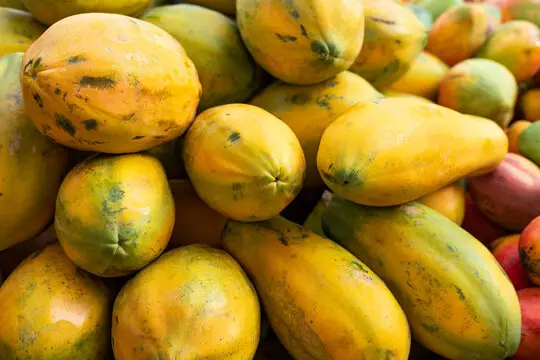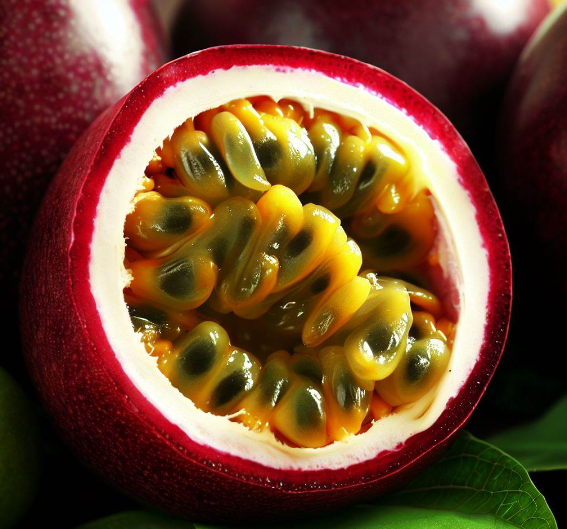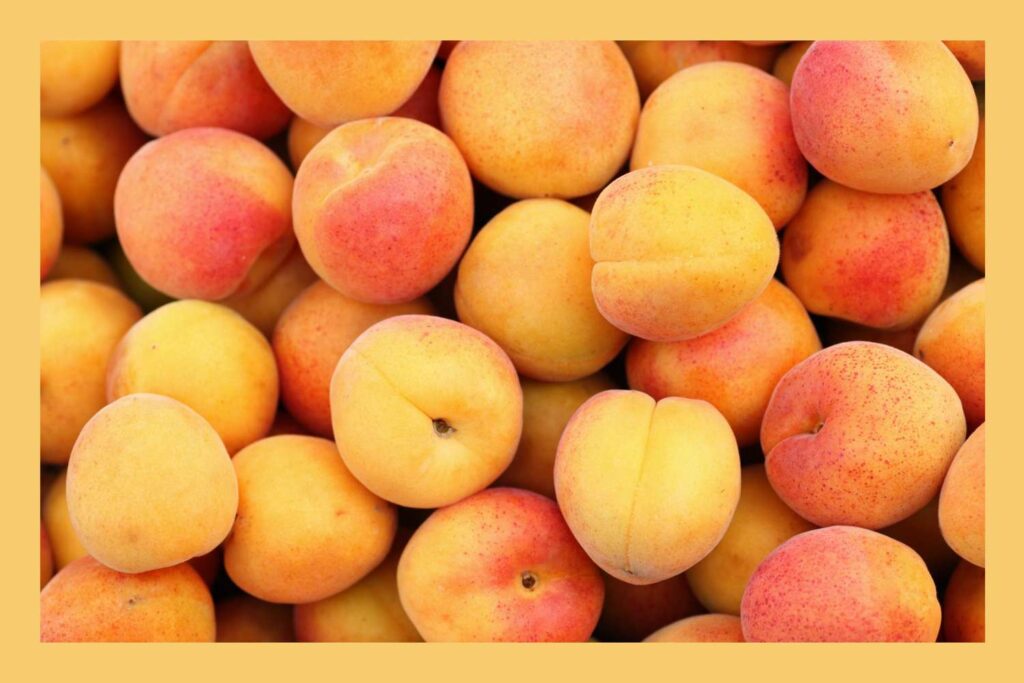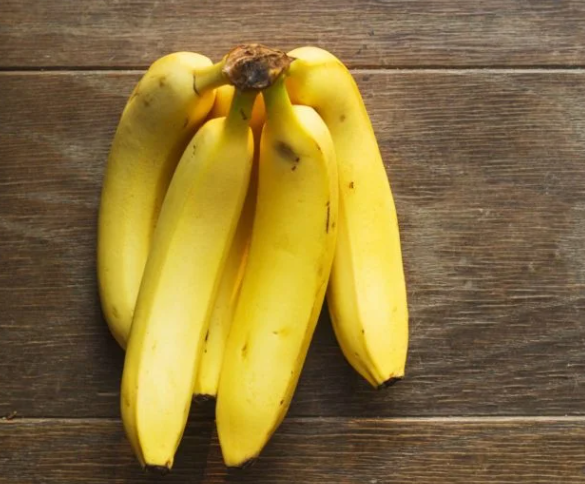Letting mangoes ripen on their own can take a long time. Usually, you’d wait several days, or maybe even a week. But what if you’re excited to eat them soon? Luckily, there are quick ways to help mangoes ripen faster.
Here are five handy methods to make your unripe mangoes ready to eat without the long wait.
Table of Contents
- 1. Paper Bag Trick
- 2. Try a Warm Spot
- 3. Paper Bag and an Apple
- 4. Surround with Ripe Fruit
- 5. Use Rice to Ripen Mangoes
- Helpful Tips for Ripening Mangoes
- How to Know When Mangoes Are Ripe
- Ways to Enjoy Ripe Mangoes
- Finishing Thoughts
- 1. Paper Bag Trick
- 2. Try a Warm Spot
- 3. Paper Bag and an Apple
- 4. Surround with Ripe Fruit
- 5. Use Rice to Ripen Mangoes
- Helpful Tips for Ripening Mangoes
- How to Know When Mangoes Are Ripe
- Ways to Enjoy Ripe Mangoes
- Finishing Thoughts
1. Paper Bag Trick
A simple way to speed up ripening is to put your mangoes in a paper bag. The bag keeps the natural gas (ethylene) that mangoes give off close to the fruit. This gas helps the ripening process.
Just put the unripe mangoes into a brown paper bag and fold the top down. You want it closed, but not tight – air should still flow through. Place the bag at room temperature. In one or two days, your mangoes should be softer and smell sweet.
You can make ripening happen even quicker by adding a banana or an apple into the bag. These fruits give off more ethylene gas, helping the mangoes along.
Touch the mangoes every day to see if they’re ready. Once they’re a little soft when you push lightly, they’re ripe and good to eat.
2. Try a Warm Spot
Keeping mangoes in a warm place is another way to make them ripen faster. Heat helps the process along. But it shouldn’t be too hot – ideally between 65-75°F.
Look for warm areas like a sunny window ledge, on top of a fridge, or in a garage. A mild heating pad can work too, but on the low setting. Avoid hot areas or direct sunlight, as this can spoil the fruit. With this method, keep an eye on your mangoes to make sure you don’t overdo it.
3. Paper Bag and an Apple
Combining the paper bag with an apple or banana can make your mangoes ripen even more quickly. The trapped ethylene from the apple helps the process.
Put the unripe mango and an apple in a paper bag. You might also want to keep this in one of the warm spots we mentioned. This makes the ethylene gas work better. Check on the fruit every day, and take the mango out when soft.
4. Surround with Ripe Fruit
Another trick is to put unripe mangoes next to already ripe fruit like bananas, apples, or peaches. These fruits release lots of ethylene, which will speed up the ripening of your mangoes.
You can use a fruit bowl on the counter or a paper bag for this. Or wrap the mango in newspaper with a ripe banana. The ethylene gas stays closer to the mango, which makes it ripen faster.
5. Use Rice to Ripen Mangoes
An unexpected but effective way to ripen mangoes is by burying them in uncooked rice. Rice can help by keeping the ethylene gas close to the mangoes and insulating them.
Put your mangoes in an airtight container and bury them in rice. Keep the container warm for a day. Once the mangoes are fragrant and give in a little to pressure, they’re ready.
Helpful Tips for Ripening Mangoes
Here are some tips for the best results when ripening mangoes:
- Choose unripe mangoes that are firm and not damaged. They ripen better than those already starting to soften.
- If you’re not using other methods, keep unripe mangoes in a folded paper bag.
- Spread mangoes out so the ethylene gas can reach all sides.
- The best temperature for ripening is 65-75°F. Avoid direct sunlight or temperatures over 75°F.
- Touch and smell the mangoes every day to see if they’re ripe.
- Once they’re ripe, enjoy them right away or put them in the fridge.
- Use an apple, banana, or tomato to add more ethylene and ripen mangoes quicker.
- You can mix methods, like using a bag and ripe fruit, to ripen mangoes even faster.
With these easy ways, you don’t have to wait too long to eat your mangoes. When fruit ripens properly, it tastes sweeter and better. Use these five tips to ripen mangoes and enjoy their tropical flavor.
How to Know When Mangoes Are Ripe
It’s important to know when mangoes are just right to eat. Look for these signs to enjoy at their best:
- They smell like sweet mangoes.
- They’re a bit soft when you squeeze them gently.
- Their skin color turns yellow, orange-red, or gets a blush.
- The skin near the stem gets a bit wrinkly and is smooth and thin.
- Their flesh is soft when pressed and isn’t stiff or stringy.
- The color inside changes from white or pale yellow to a deep yellow.
Mangoes don’t get any riper after they’re picked. Let them fully ripen on your counter before you chill them to keep their ripe taste and feel. Fresh ripe mangoes are best if eaten in 2-3 days.
Look for signs like color, smell, and texture to know when a mango is ripe and ready to eat. It will taste best when it’s ripe.
Ways to Enjoy Ripe Mangoes
When your mangoes are ripe, you can have fun eating them in different ways:
- Enjoy the sweet taste by eating them on their own
- Put slices on top of yogurt, cereal, or porridge
- Add them to a fruit salad or salsa for extra flavor
- Mix them into a smoothie, make a lassi, or freeze them into ice pops
- Make them into a sauce, like chutney, for curries or to marinate food
- Use mangoes to make sweet desserts like pies, tarts, and cakes
Ripe mangoes are sweet and full of flavor. Have fun trying them in different meals.
Make sure you wash the mangoes first. Then you can cut them up, mix them into dishes, or just enjoy a bite right away. Ripe mangoes can be used in so many tasty recipes!
Finishing Thoughts
You might be thinking, “How long do mangoes take to ripen?” Well, it depends on how ripe they are to begin with and what you do to help them ripen. Usually, it takes about a day or even a few days for them to get just right. Keep an eye on them so they don’t get too ripe.
If you’re excited to eat ripe mangoes, you can use some tricks to make them ripen faster. Pick mangoes that are still firm and give them a little time to ripen. When they’re ready, you’ll get to enjoy all the amazing tastes and uses of mangoes.
Mangoes are sweet and tasty, and they’re great for many dishes. But if you bite into one that isn’t ripe yet, it’s not pleasant – it’ll be hard, sour, and not enjoyable. It’s important to ripen mangoes the right way to enjoy their flavor.
Letting mangoes ripen on their own can take a long time. Usually, you’d wait several days, or maybe even a week. But what if you’re excited to eat them soon? Luckily, there are quick ways to help mangoes ripen faster.
Here are five handy methods to make your unripe mangoes ready to eat without the long wait.
1. Paper Bag Trick
A simple way to speed up ripening is to put your mangoes in a paper bag. The bag keeps the natural gas (ethylene) that mangoes give off close to the fruit. This gas helps the ripening process.
Just put the unripe mangoes into a brown paper bag and fold the top down. You want it closed, but not tight – air should still flow through. Place the bag at room temperature. In one or two days, your mangoes should be softer and smell sweet.
You can make ripening happen even quicker by adding a banana or an apple into the bag. These fruits give off more ethylene gas, helping the mangoes along.
Touch the mangoes every day to see if they’re ready. Once they’re a little soft when you push lightly, they’re ripe and good to eat.
2. Try a Warm Spot
Keeping mangoes in a warm place is another way to make them ripen faster. Heat helps the process along. But it shouldn’t be too hot – ideally between 65-75°F.
Look for warm areas like a sunny window ledge, on top of a fridge, or in a garage. A mild heating pad can work too, but on the low setting. Avoid hot areas or direct sunlight, as this can spoil the fruit. With this method, keep an eye on your mangoes to make sure you don’t overdo it.
3. Paper Bag and an Apple
Combining the paper bag with an apple or banana can make your mangoes ripen even more quickly. The trapped ethylene from the apple helps the process.
Put the unripe mango and an apple in a paper bag. You might also want to keep this in one of the warm spots we mentioned. This makes the ethylene gas work better. Check on the fruit every day, and take the mango out when soft.
4. Surround with Ripe Fruit
Another trick is to put unripe mangoes next to already ripe fruit like bananas, apples, or peaches. These fruits release lots of ethylene, which will speed up the ripening of your mangoes.
You can use a fruit bowl on the counter or a paper bag for this. Or wrap the mango in newspaper with a ripe banana. The ethylene gas stays closer to the mango, which makes it ripen faster.
5. Use Rice to Ripen Mangoes
An unexpected but effective way to ripen mangoes is by burying them in uncooked rice. Rice can help by keeping the ethylene gas close to the mangoes and insulating them.
Put your mangoes in an airtight container and bury them in rice. Keep the container warm for a day. Once the mangoes are fragrant and give in a little to pressure, they’re ready.
Helpful Tips for Ripening Mangoes
Here are some tips for the best results when ripening mangoes:
- Choose unripe mangoes that are firm and not damaged. They ripen better than those already starting to soften.
- If you’re not using other methods, keep unripe mangoes in a folded paper bag.
- Spread mangoes out so the ethylene gas can reach all sides.
- The best temperature for ripening is 65-75°F. Avoid direct sunlight or temperatures over 75°F.
- Touch and smell the mangoes every day to see if they’re ripe.
- Once they’re ripe, enjoy them right away or put them in the fridge.
- Use an apple, banana, or tomato to add more ethylene and ripen mangoes quicker.
- You can mix methods, like using a bag and ripe fruit, to ripen mangoes even faster.
With these easy ways, you don’t have to wait too long to eat your mangoes. When fruit ripens properly, it tastes sweeter and better. Use these five tips to ripen mangoes and enjoy their tropical flavor.
How to Know When Mangoes Are Ripe
It’s important to know when mangoes are just right to eat. Look for these signs to enjoy at their best:
- They smell like sweet mangoes.
- They’re a bit soft when you squeeze them gently.
- Their skin color turns yellow, orange-red, or gets a blush.
- The skin near the stem gets a bit wrinkly and is smooth and thin.
- Their flesh is soft when pressed and isn’t stiff or stringy.
- The color inside changes from white or pale yellow to a deep yellow.
Mangoes don’t get any riper after they’re picked. Let them fully ripen on your counter before you chill them to keep their ripe taste and feel. Fresh ripe mangoes are best if eaten in 2-3 days.
Look for signs like color, smell, and texture to know when a mango is ripe and ready to eat. It will taste best when it’s ripe.
Ways to Enjoy Ripe Mangoes
When your mangoes are ripe, you can have fun eating them in different ways:
- Enjoy the sweet taste by eating them on their own
- Put slices on top of yogurt, cereal, or porridge
- Add them to a fruit salad or salsa for extra flavor
- Mix them into a smoothie, make a lassi, or freeze them into ice pops
- Make them into a sauce, like chutney, for curries or to marinate food
- Use mangoes to make sweet desserts like pies, tarts, and cakes
Ripe mangoes are sweet and full of flavor. Have fun trying them in different meals.
Make sure you wash the mangoes first. Then you can cut them up, mix them into dishes, or just enjoy a bite right away. Ripe mangoes can be used in so many tasty recipes!
Finishing Thoughts
You might be thinking, “How long do mangoes take to ripen?” Well, it depends on how ripe they are to begin with and what you do to help them ripen. Usually, it takes about a day or even a few days for them to get just right. Keep an eye on them so they don’t get too ripe.
If you’re excited to eat ripe mangoes, you can use some tricks to make them ripen faster. Pick mangoes that are still firm and give them a little time to ripen. When they’re ready, you’ll get to enjoy all the amazing tastes and uses of mangoes.


![What Is the National Fruit of Korea And Why? [ANSWERED]](https://fruitonix.com/wp-content/uploads/2023/04/What-Is-the-National-Fruit-of-Korea-And-Why-1024x683.jpg)




![What Is the National Fruit of Ecuador and Why? [ANSWERED]](https://fruitonix.com/wp-content/uploads/2023/04/What-Is-the-National-Fruit-of-Ecuador-and-Why-1024x637.jpg)

